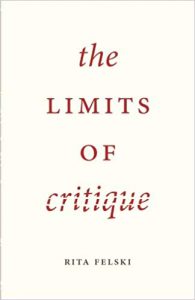Regressive Left
Suspicion and the Corruption of the Liberal Mind
Suspicious reading is applied to any and every medium as well as every form of individual expression.

What is the difference between leftists and cannibals? Cannibals don’t eat their friends.
~attributed to Lyndon Johnson

I am liberal to my core and like many liberals I’ve become increasingly disturbed by the escalation of totalitarian impulses on the Left. For the past six years I’ve been exploring the phenomenon and teasing out its underlying dynamics. While many writers and thinkers have been going head-to-head with extremists and confronting their ideological inconsistencies, the book I’ve found most helpful is Rita Felski’s The Limits of Critique (University of Chicago Press, 2015). Unlike other writers, Felski approaches the dynamic obliquely and her foundational point is more subtle.
How we feel is almost always the first signal we have about the nature of our surroundings. For example, all of us have had the experience of walking into restaurant with a friend; all of us engage in some form of the following when we do: We stop just inside, pause a moment, and get a feel for the place. And every one of us has, at one time or another, turned to our friend and said, “This place feels weird, let’s leave.” It is our sensate perception of what might be called the atmosphere of a place—or as Felski has it, its “mood”—that can, if attended to, reveal deeper aspects of it nature.
I suspect the discomfort many of us are experiencing with the Left begins, as it did for me, with a strong, pre-verbal aversion to the mood permeating its activism. As the writer Thomas Cook once remarked, “There are moral fault lines to whose subtle trembling we must remain alert.” Our sensitivity to that trembling alerts us but it takes time and a great deal of contemplation to unlock just why it has occurred. Felksi is someone who has taken the time.
She makes a seminal point early in the book that critique, of whatever sort, possesses a mood, an atmosphere, a specific feeling. It doesn’t belong to a specific place, however, but rather to a certain style of thought. It is that mood that, by its nature, has infected every form of critique including critical race theory and intersectionality.

With surgical precision Felski unlocks the mood’s deeper meanings, then explores how much they interpenetrate every aspect of our lives. She begins carefully, defining just what the word ‘mood’ means.
[It] refers to an overall atmosphere or climate that causes the world to come into view in a certain way. Moods are often ambient, diffuse, and hazy, part of the background rather than the foreground of thought. . . .It “sets the tone” for our engagement with the world, causing it to appear to us in a given light.
In essence, it is a perceptual lens that affects how we see everything, including literature.
It colors the texts we read, endows them with certain qualities, places them in a given light. A certain disposition takes shape: guardedness rather than openness, aggression rather than submission, irony rather than reverence, exposure rather than tact. . . . Critique inhabits us, and we become habituated to critique.
Inevitably, then, we begin to approach the world through…
…a spirit of skeptical questioning or outright condemnation, an emphasis on its precarious position vis-a-vis overbearing and oppressive social forces, the claim to be engaged in some kind of radical intellectual and/or political work, and the assumption that whatever is not critical must therefore be uncritical. . . . These practices combine, in differing ways, an attitude of vigilance, detachment, and wariness . . .
Culturally, this mood is now widespread. Suspicious reading is applied to any and every medium as well as every form of individual expression. We’ve become “soaked,” as she says, “in an overall tonal atmosphere” that’s so pervasive we rarely notice it. To a fish, water just is.
And while that mindset is purportedly focused on revealing and surmounting social oppressions, Doris Lessing comments (in her New York Times article about political correctness entitled “Language and the Lunatic Fringe”) that there is far more to it than that. She notes that this kind of social critique does have its good side, “for it makes us re-examine attitudes, and that is always useful.” However, she goes on to warn:
The trouble is that, with all popular movements, the lunatic fringe so quickly ceases to be a fringe, the tail begins to wag the dog. For every woman or man who is quietly and sensibly using the idea to examine our assumptions, there are 20 rabble-rousers whose real motive is desire for power over others, no less rabble-rousers because they see themselves as anti-racists or feminists or whatever.
While my liberal tribe easily perceives the dangers within non-liberal political or social movements, it cannot see them within its own. It has little understanding of the drive for power over others that exists, to varying extents, within most human beings; nor does it understand that many of its members have assumed protective coloring to achieve that power. Felksi’s great contribution is illuminating the truth that our sensate perception of the mood permeating leftist activism grants us access to its underlying mental orientation—something she calls “the hermeneutics of suspicion.”
It is this orientation which underlies all contemporary critical theory and which, through concept creep, has come to permeate much of Western liberal thought. It now defines the mindset a ‘true’ liberal must adopt towards the social and political structures around us. “Radicalism of thought,” she says,
…now calls for intensive acts of deciphering, thanks to a heightened sense of the duplicity of language and the uncertain links between signs and meaning. Their aim is not just to underscore the unreliability of knowledge . . . . Rather these thinkers instantiate a new suspicion of motives—of the ubiquity of deception and self-deception.
As she continues:
The spread of poststructuralist theories [have schooled social critics] in preternatural alertness and vigilance. [Suspicion is] no longer a temporary way station on the path to a newly discovered truth, it is a permanent domicile and dwelling place for criticism . . . . This entrenching of suspicion in turn intensifies the impulse to decipher and decode. The suspicious person is sharp-eyed and hyperalert; mistrustful of appearances, fearful of being duped, she is always on the lookout for concealed threats of discredited motives. In short: more suspicion means ever more interpretation.
And the more the mindset is used, the more application it appears to have:
Knowing full well that all-powerful forces are working behind the scenes, the critic conjures up ever more paralyzing scenarios of correction and control. Like the clinically paranoid individual, she feeds off the charge of her own negativity, taking comfort in her clear-eyed refusal of hope and her stoic awareness of connections and consequences invisible to others. . . . In its exclusion of contingency and indifference to counterexample, it shades into tireless tautology, rediscovering the truth of its bleak prognoses over and over again.
Those who have absorbed the mindset now extend suspicious reading to everyone and everything anyone does: words, body language, dress, hair, music, art, even food. They actively reject the face value of communication, whether literary or social; hold nothing as innocent of power motivations, whether directly or through unconscious complicity in those power motivations.

To regard the majority of Western peoples as possessing malign motives; to base a life upon such a point of view; to approach all books, plays, art, and human interactions with this kind of suspicion is not, however, a sign of clear-eyed perception but rather, as one of my psychology professors once put it, a diseased mind. Like its more extreme cousin, paranoia, it becomes self-perpetuating: the more suspicious one is, the more vigilant one becomes; the more vigilant one is, the more evidence one finds in even the most innocent of behaviors; and the more evidence one finds, the more suspicious one becomes.
Recognizing the mood that permeates this mindset empowers those of us who struggle to create alternatives to ground what we do in an approach significantly different in its feeling, one that does not by nature, splinter community and destroy dialogue, but rather enhances them.
There is much more to Felski’s book of course. Her identification of the suspicious nature of the critical mood merely sets the foundation for further explorations, most importantly the answer to the question of why this mood, among all possible moods, taken hold as the de facto sensible choice for so many liberals?
She finds its ancient genesis in what she terms philosophical suspicion which, over time, has extended itself into academic suspicion, then, through concept creep, into literary suspicion, and finally into vernacular suspicion—that is, a pervasiveness within and among the democratic populace of the Western world. She explores vernacular suspicion in depth, initially through psychotherapy’s uncovering of the unconscious motivations behind behavior and then detective fiction’s unlocking of the concealed motivations of criminals. Towards the end of the book, Felski develops her second significant contribution: a hermeneutics that is at heart not destructive but redemptive.
Felski is, by the way, poignantly aware of the irony in exploring and finding hidden dynamics within a critical approach that focuses on the hidden motivations of others. But there is one significant difference between her approach and that of critical theory. As she makes clear, while critical theory is useful for some of the insights it uncovers, it is at its core destructive. It possesses within itself no hermeneutics of reparation or redemption, hope or love, compassion or forgiveness. It can tear apart but it cannot rebuild. It is a binary, either/or view of life which denies the complexity of the human heart. And it is a compassionate understanding of that complexity that I believe we most desperately need now.
Our creation of alternatives depends initially on our capacity to recognize the pervasive mood within leftist extremism. Secondly, we must have the courage to choose a path not rooted in suspicion. The necessity of confronting the logical fallacies within a worldview we find repugnant remains but we can also, through our behavior and words, bring a life-generative alternative to the conversation. The moral fault line of which Thomas Cook speaks, runs through the center of the human heart. And it is the feelings of our hearts that we must reclaim in order to find life-enhancing alternatives.
True liberalism does not lie in a dissociated rationalism rooted in disembodied theoretical structures which its proponents insist completely explain ourselves and our world. It is found through depth and nuance of thought, our capacity to feel, the development of our redemptive natures, in humility, in the refusal of blind devotion to any dogma—even those close to our hearts, and finally, in our capacity to love and forgive.






